
Mold and mildew negatively affect many kinds of wild and cultivated plants. Powdery mildew (PM) and Botrytis (Bud rot) are two of the most common fungi that damage and, sometimes, destroy cultivated crops.

Powdery mildew is the collective term for several species of fungi that have similar presentation and cause similar negative health effects in plants. It usually presents as distinctive white, fuzzy or ‘powdery’ patches on any above ground part of the plant (stems, leaves, stalks, petioles, buds, etc.). Sometimes it can appear like little spots of “flour” on leaves or any other above-ground parts of the plant.
New shoots and lower/central leaves are commonly the initial sites of PM infection. Old leaves also have a high probability of getting initial PM infection due to their age and, most often, their position within the plant’s branches and other leaves.
Plants with a thick layer of leaf cover are also high risk for PM due to the density of plant material in a given volume which can cause a lack of proper air flow and create breeding grounds for powdery mildew deeper within the plant’s leaves and branches.
Often PM begins as a circular or oval patch that spreads quickly if not dealt with. If left untreated, PM will spread all over the plant and render the crop unfit for human consumption. PM can cause leaves to yellow and fall prematurely which negatively impacts the plant’s ability to photosynthesize the sugars it needs to live. If not dealt with quickly, PM can ruin whole crops as it spreads from plant to plant in your field, greenhouse, indoor facility/grow room, etc. which can take a serious emotional and financial toll on growers.
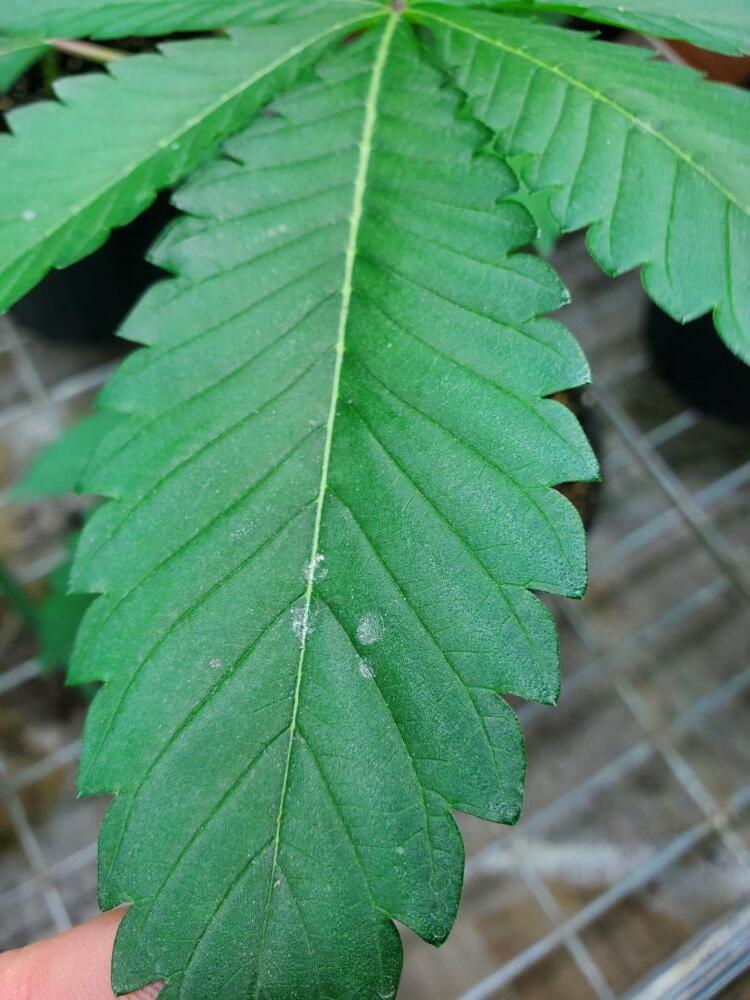
Powdery Mildew sites beginning near the center of a fan leaf. Note their circular shape and almost powdery appearance
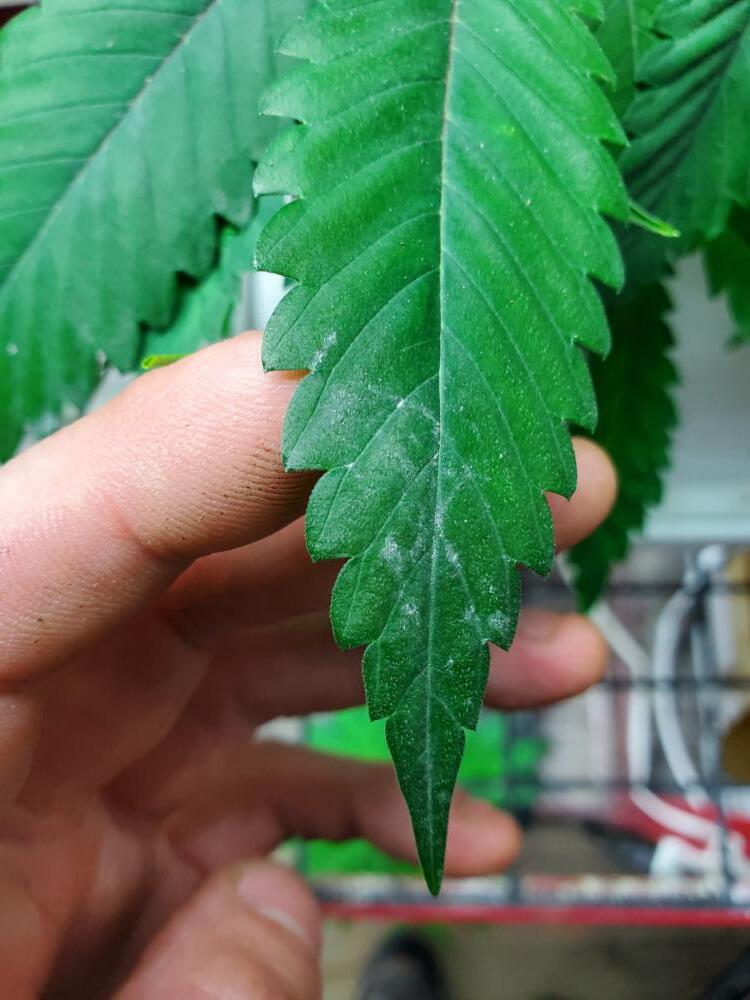
Another fan leaf showing powdery mildew sites, this time near the blade tips.

Botrytis is another common pathogenic fungus found virtually everywhere plants are grown. Like Powdery mildew, Botrytis first appears as a white growth but quickly becomes brown or gray and can make buds and leaves appear “crispy” or over-dried. It can also sometimes make buds look webbed and slimy depending on the stage of infection. Botrytis is dangerous for humans and plant product containing this fungus should be considered toxic and unusable.
Botrytis can affect ANY part of the plant including the roots which makes it a very pervasive and difficult issue to treat. Botrytis will often affect new shoots as well as areas of the plant that do not get proper aeration such as dense buds or areas of high leaf coverage. Thick leaf layers and high relative humidities combined can make breeding grounds for this fungus just like they can for powdery mildew. Damaged plant stalks and leaves are also highly susceptible to PM and Botrytis infection. It is recommended to remove any petioles (leaf stems) still attached to stalks when defoliating plants during normal pruning. Petioles left over are highly susceptible to fungal infection and should be removed entirely from the plant if the leaf it was attached to is pruned.

Photo: Pong Pong/Shutterstock
White bud rot taking hold within the bud. Note the spider web-like texture
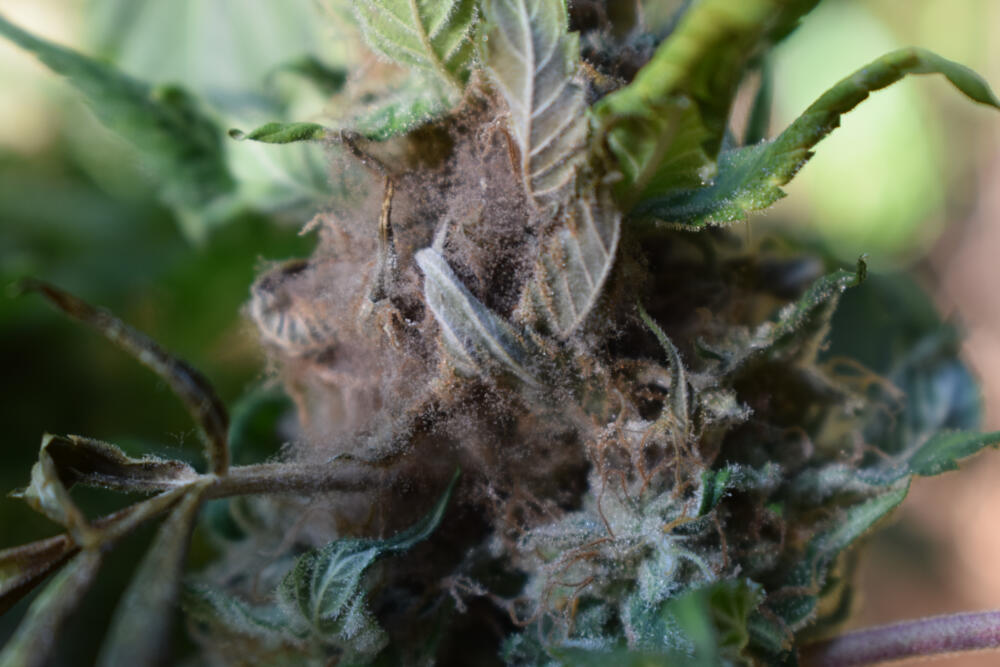
Photo: Pong Pong/Shutterstock
A severely infected bud. Note the webbed texture and brown color of the bud rot. This bud will have to be removed before the infection spreads too far.
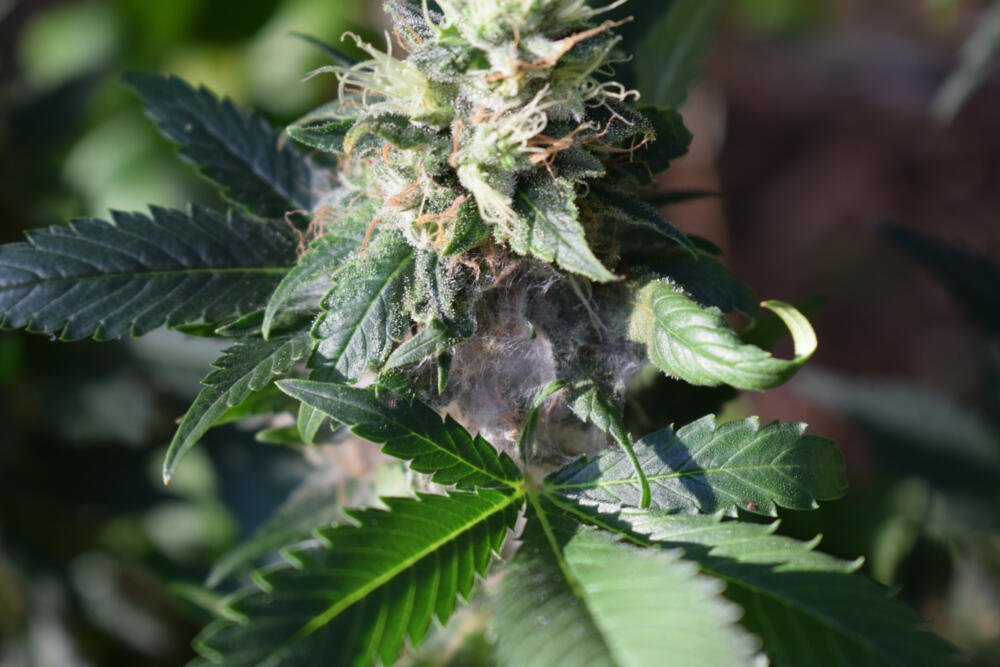
Photo: Pong Pong/Shutterstock
More exposed botrytis working its way up the young bud
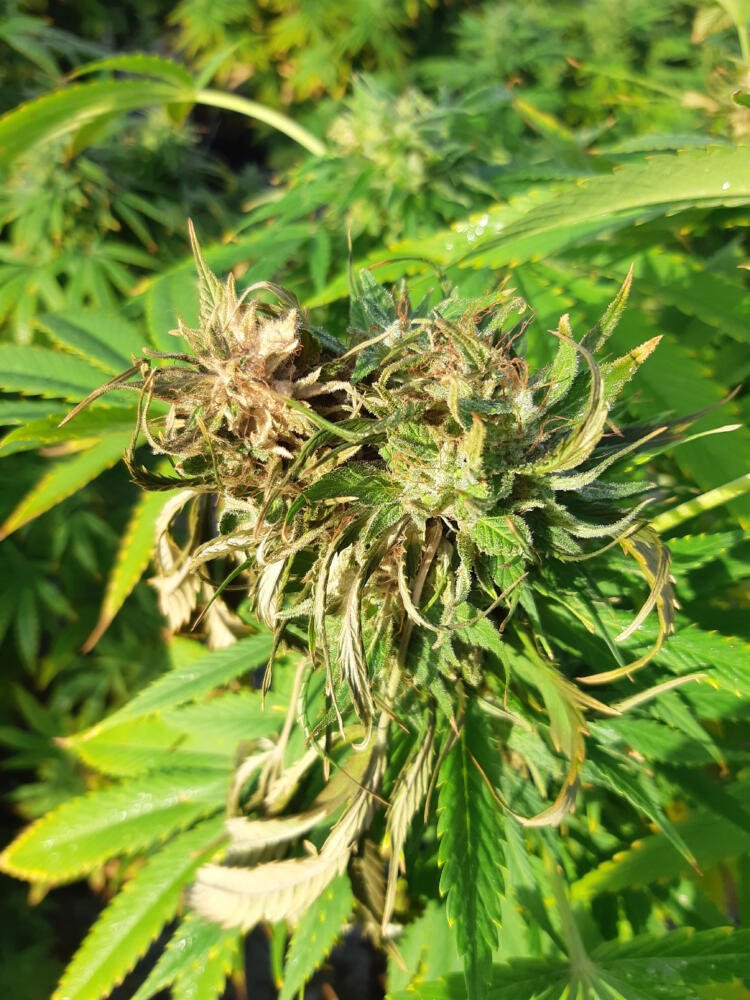
Photo: KilnKam/Shutterstock
Sometimes botrytis will make the bud look caky and dry. This bud will need to be removed from the area to prevent further spread of the mold to other plants.
Botrytis:
-Dry or webbed texture
-Begins white but quickly turns brown or gray
-Affects ALL parts of plant (above and below ground)
-Geometric pattern not similar across plants
Powdery Mildew:
-Powdery or ‘flour’ like texture
-White
-Affects above ground parts of plant
-Generally circular or ovoid (oval) patterning that spreads outward from center

It may sound obvious but the best way to protect your crop is to prevent mold outbreaks before they happen. Below are some tips on preventing powdery mildew and Botrytis in your grow space.
Prevention:
-Keep Plants Healthy (Correct feeding)
-Good light penetration
-Good air flow/ventilation
-Targeted defoliation
–Clean/Sterilized cutting tools and work surfaces
-Appropriate crop density
-Monitor plants and room often to spot issues as they arise
Treatment:
-Remove affected areas of plant
-Increase ventilation to room
-Discard all affected plant material outside of grow space ASAP
-Destroy/Remove entire plant if mold infection is too wide spread
-Change gloves or wash hands after removing affected plant material
Keep Plants Healthy:
Avoid over or under feeding your plants as nutrient imbalances can cause serious stress which diminishes the plant’s ability to naturally fight off pests and fungal infections. When a plant is taking up the appropriate amount of nutrients and water, and when it produces healthy levels of sugars within itself, it is able to resist disease and infestation to a much higher degree, if not entirely. The healthier your plant is, the less work you have to do for a better yield.
Appropriate Light Penetration:
Make sure your plants are getting good light penetration to decrease mold’s ability to infect lower bud sites, branches, and leaves. Mold does well in wet, dark conditions so increasing the light coverage on your plant will decrease mold’s ability to harm your crop. Be careful not to place your lights too close to the top of your plants or leaves as this can cause light burn which can stress the plant out.
There are various heights above the plant canopy that are optimal depending on type of light used (e.g. LED, MH, HPS, T5, etc.) and the technical specifications of any individual light. Keeping lights approximately 18 – 24 inches above your plant canopy is usually a safe bet but again consult the manual or manufacturer website for the unique specifications and any recommendations that may be found for the specific light(s) you’re using.
Air Flow:
It is critical to have proper air flow in your grow to prevent pockets of stale air and humidity from building up within the foliage or on stems or soil. In indoor grow spaces, wall and floor fans can be used to create air flow. Be cautious with the power setting and how close the fans are to the plants. The air movement is critical to preventing mold but too much force from air on the leaves will damage their structure and can lead to deformation and eventual premature death of the leaves.
Some indoor grow rooms and many commercial facilities also use HVAC systems to help recycle air in their grow space. These systems help to prevent accumulation of stale air, pathogens, mold spores, and excess humidity as well as introduce fresh air and CO2. If you can keep your grow area’s relative humidity below 60% (45% – 55% RH is optimal for flowering) you will greatly decrease the chances of mold outbreak. Many detrimental fungi and bacteria have a harder time establishing in an area that has less than 60% RH. Mold outbreaks can still occur at below 60% RH if grow area cleanliness is not maintained but will be less severe and will grow more slowly than at higher RH levels. Keeping a lower RH can help growers have more time to spot and treat any fungal infections that occur.
In grow tents, intake and outtake fans are usually employed to help keep fresh air recycling into the tent and stale air/excess moisture out of the tent. Small, clip-on fans can often be placed on tent poles to help with air motion if you find the air in the tent is still too thick, humid, or stationary. Again, be cautious at what setting you put the fan(s) at and how close it is to the foliage. Again a relative humidity of less than 60% is preferable to reduce the potential of fungal infection
If growing outdoors, make sure your crop is planted in an area that gets good wind flowing through it. Check on the foliage, stems, buds (if in flower) and surrounding soil daily, or as often as you can, to monitor those areas of your plants for white, gray, or brown spots forming. It’s also helpful to monitor for any pest damage/infestations and treat these appropriately as soon as possible.
Targeted Defoliation:
Defoliation can improve air flow around your plant and can reduce the chance of mold outbreaks. It can also help the plant increase yields and potency by re-allocating energy from leaves that are older and/or may be shading out flower sites to flowers and newer leaves that are more efficient in photosynthesis (greener, more chlorophyll).
Defoliation requires some experience to get the hang of and must be approached with caution. Too much leaf removal can cause your plants stress which can harm yields and potency as well as lower the plant’s ability to fight off pests and fungal infections.
Defoliation is much more common in indoor grow spaces as leaves may not be receiving light evenly and thus some leaves may not contribute their maximum potential for photosynthesis. It still can sometimes be helpful when growing outdoors if your plant has a high leaf density that’s preventing good air flow but isn’t as big of a concern usually as it may be for the indoor grower.
Many small leaves on the underside of the plant and within the plant structure on lower branches can be removed to improve air flow while removing less efficient leaves. Be cautious not to defoliate too many leaves at once or in one day. It can be helpful to remove some leaves every 3-7 days during later stages of vegetative growth and/or within the first 3 weeks of the flowering phase. Try to not remove more than a total of 10-20% of a single plant’s foliage to avoid stressing it out.
ALWAYS USE CLEAN/STERILIZED TOOLS WHEN REMOVING LEAVES!
This fact cannot be stressed enough as dirty cutting tools (scissors, razor, scalpel,) can lead to greater chances of infection from bacteria, mold, and plant viruses/viroids. 70% isopropyl alcohol is recommended for sterilizing cutting tools against bacteria, but a 10% solution of bleach is recommended for sterilizing cutting tools against mold spores, plant viruses and viroids as isopropyl will not kill viroids.
Try to fully remove petioles (leaf stem) when defoliating to avoid creating sites that are optimal for fungal infection. We recommend removing the leaf, cut at the base of the petiole where it connects to the plant stalk. Try not to twist, rip, pull, or otherwise tear at the leaves as this can cause wounds in the stem and leave behind pieces of leaf and petiole debris that act as sites for initial fungal infection.
Check out our defoliation guide for more precise information regarding defoliation techniques.
Plan Healthy Crop Density:
It is important not to plant or place individual plants too close to one another. Appropriate spacing in your tent, grow room, facility, or outdoor field improves air flow and decreases the chances of fungal infection. It also helps to avoid moisture/humidity build up within and between plants.
Before stocking your grow area, plan ahead to choose the number of plants and the desired size of those plants appropriate for the space you’ll be growing in. This will help prevent overcrowding and allow better air flow and light penetration to all of your plants.
Clean Grow Spaces in Between Harvests:
Keeping your grow space clean and as plant debris free as you can is immensely helpful in preventing fungal infections. Clean floors, walls, and ceilings as well as any objects in the room in between harvests to eliminate any mold spores growing and keep new ones from gaining a foothold. There are many products that can be used to eliminate mold spores. A solution of 10% household bleach and 90% water is very effective in removing most mold spores. Distilled white or cleaning vinegar is also another easily obtainable option for cleaning grow spaces as it has a high acetic acid content which has antifungal properties. Vinegar is effective against many but not all types of mold spores.

Prune the affected parts of the plant if possible. If there is mold growth on leaves, remove the entire leaf and petiole (leaf stem) and put these gently into a plastic bag or other container. If removed with too much force you may inadvertently knock spores into the air which will travel to other parts of your plant or to other plants in the grow area. After you’re done removing affected leaves, quickly remove moldy leaf debris and throw away outside of the grow area, and outside of your home or facility if possible.
If mold is growing throughout a stalk or bud, removal of infected areas is necessary. A good rule of thumb is to prune a few inches below the infected site and remove all affected plant material.
There are some products available that are advertised as being able to clean finished bud from mold with little to no residual chemicals left in your flower after treatment. Due diligence to do your research on specific products that claim this is vital to ensure effective and non-toxic methods of cleaning bud if this is a strategy you wish to employ.
There are also many fungicides available commercially that work for vegging plants but many have potentially long lasting health effects so once again, do your research before introducing any new chemicals to your grow.
Neem Oil:
A natural fungicide that has been used for many years is neem oil. Neem oil is a naturally occurring oil that comes from the seeds of the neem tree. Neem has been proven to have antifungal as well as anti-insecticidal properties and is not harmful to humans or pets. However, if you grow outdoors, be sure to not spray neem oil on plants bees may visit (flowers, vegetables, other pollen sources, etc.) as it can be harmful to them.
Copper Based Fungicides:
Copper based fungicides are another non-systemic option for mold prevention and treatment. They are non-harmful to pets and humans and can be applied (if mixed in the appropriate ratio) without burning your cannabis plants. Copper based fungicides have shown great efficacy in killing mold spores and preventing their growth if applied correctly.
We do not recommend using any copper based fungicidal sprays outdoors as this can be harmful to earthworms and beneficial bacteria which are vital to soil health. However, if growing indoors without using living soil then copper fungicides can be a very effective treatment and preventative option for PM and botrytis. Copper fungicides are non-systemic and won’t harm your cannabis plants if applied in the appropriate ratios which can be found in the product manual that comes with the fungicide.
Baking Soda:
Baking soda is another way to organically deal with powdery mildew and mold. Mix half a teaspoon of baking soda per quarter of a gallon of water, put this solution into a sprayer and spray the affected leaves and stems of your plant. Baking soda is another non-systemic fungicide which means it will potentially need to be re-applied if the issue reoccurs but it also means your plant won’t take it up within itself which is a very good thing when it comes time to enjoy your dried flower.
Do Your Research:
No one wants to ingest fungicide when enjoying their bud so avoid using synthetic chemicals that are systemic and stay within the plant. Some fungicides won’t flush out after the normal flushing period at the end of flower so be careful not to employ these chemicals as they are largely for ornamental crops and lawns that are not intended for ingestion by humans or animals. Always read the labels and warnings with any new product you introduce to your grow to keep yourself, others, and the environment safe.
Fungicide/Defoliation Not Working:
We do recommend removing and destroying heavily affected plants in situations where defoliation and/or pruning are unable to appropriately remove fungal infection sites. Sometimes the spread of mold and mildew is so vast over the plant’s surface that it is safer to remove the plant entirely before the issue spreads to the rest of the room. Be sure to wear gloves while removing infected areas of plants or while removing whole plants and throw those gloves away before touching clean surfaces or other plants. This practice will limit the spread of mold spores which can destroy your crop quickly. If gloves aren’t available, wash your hands thoroughly as soon as possible to avoid further spread of any fungi.
Make sure to increase the ventilation to the grow space to keep mold from coming back and establishing a foothold.
Fungus and mildew are huge concerns for any grower whether they are a home or commercial grower. If left untreated it can destroy whole crops by negatively affecting plant health, diminishing yields, and rendering infected, untreated plant material hazardous for human consumption. With proper environmental conditions and adherence to best growing practices you can avoid the catastrophe of diminished yields and the loss of an entire crop. Always be cautious if utilizing any fungicidal treatment. Always read the labels and warnings on the product and do your research before applying anything new to your grow room or garden. We hope this introductory guide has been helpful and that you enjoy many great, mold-free harvests in the seasons to come!
